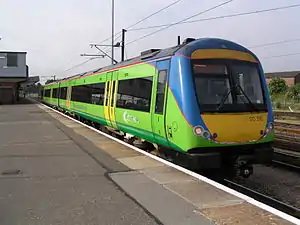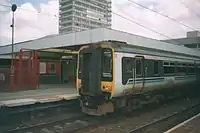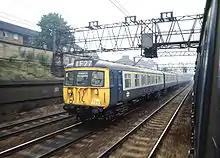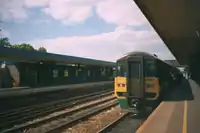Central Trains
Central Trains[1] was a train operating company in the United Kingdom owned by National Express that operated a variety of local and inter-regional trains from 2 March 1997 until 11 November 2007.
 | |
 A Class 170 Turbostar at Peterborough in 2004 | |
| Overview | |
|---|---|
| Franchise(s) | Central Trains 2 March 1997 – 11 November 2007 |
| Main region(s) | Midlands (East, West) |
| Other region(s) | North West England, East Anglia, South East Wales |
| Fleet size | 156 |
| Stations called at | 232 (193 operated) |
| Parent company | National Express |
| Reporting mark | CT |
Overview
Created out of the Central division of Regional Railways during the Privatisation of British Rail, Central Trains passed into the private sector on 2 March 1997.[2] The franchise was awarded to National Express, who maintained control of the company until its eventual demise in 2007. Central Trains employed over 2,400 staff.[3]
The company invested significantly in rolling stock, with significant orders for new trains placed and the fleet later further grown through the acquisition of trains made surplus by other companies. Despite a reduction in the area covered during the ten years of its existence, the company grew its core fleet from fewer than 300[2] passenger vehicles to a total of 379[3][4] – a capacity increase of over 28%. It also refurbished a number of its stations, introducing ticket gates, help points and live information boards.
Central Trains also clamped down on vandalism on its trains and fare evasion, including through a controversial poster campaign publicising the names and addresses of passengers who had been fined for not having valid tickets.[5]
The franchise gained a reputation for poor timekeeping: its best performing period between 2000 and 2007 still saw one in six trains five minutes late or more,[6] with punctuality dropping as low as 61% in 2003.[7] The company also suffered from ongoing staff relations problems which led to extensive and long-lasting cancellations of Sunday services.[8][9][10]
Following a government policy announced in 2004, Central Trains was eventually disbanded in November 2007 with its services dispersed amongst London Midland, East Midlands Trains and CrossCountry.
Network
At its greatest extent, Central Trains operated 253 stations and provided services covering 1,534 miles of the UK's railway network, covering most of central England and Mid Wales.[11] In its last years, the company saw 43 million passenger journeys and a total of 930 million miles travelled every year.
Services ranged from rural and local services to flagship express services originally branded as Alphaline and later developed into Central Citylink. In the West Midlands, the company also operated the extensive urban rail services under contract to the Centro. (later Network West Midlands).
In the late 1990s, Central Trains offered many through services between routes which had previously been shown as self-contained in public timetables. For example, where a train had previously been timetabled to work a Shrewsbury to Birmingham service followed by a Birmingham to Leicester service, the workings were combined and shown as a single direct Shrewsbury – Birmingham – Leicester service in the public timetable. This resulted in some particularly lengthy services such as those from Aberystwyth in Mid Wales to Grimsby on the opposite coast of the UK.[12][13] This also gave rise to the nickname "The Barmouth to Yarmouth Railway" due to the fact Central Trains operated services in both Mid Wales and East Anglia (certain services were extended from Norwich to Great Yarmouth in the summer).
Central Trains had a major shakeup between 2004–05 to prepare them for the eventual break up of the franchise. The first part of this was done in 2001 when the Birmingham New Street to Chester & Mid Wales and Cambrian Coast Line was transferred into what is now the Wales & Borders franchise. In 2004 services from Leamington Spa to Birmingham Snow Hill & Stratford upon Avon were transferred into Chiltern Railways, but the company maintained a peak hours services to and from Leamington Spa. The service between Birmingham and Stourbridge was increased to every 10 minutes and this in turn increased the Kidderminster service, as a part of the new Stourbridge line timetable all remaining Birmingham New Street trains were diverted into Birmingham Snow Hill. Liverpool Lime Street to Stansted Airport split at New Street to form two services due to problems with delays. Previously Central Trains ran services from Birmingham New Street to Nottingham via Leicester as well as Derby, this service was split, the Leicester to Nottingham service was merged with the hourly Ivanhoe Line service to Loughbourgh and was extended past Nottingham all stations to Lincoln.
During 2004 Trent Valley local services that ran generally between Stafford and Nuneaton (some extended to / from Coventry or Rugby) were discontinued due to a Driver shortage and not restored until over year later, when they were replaced by an electric service from Northampton to Crewe. Another fatality of the ‘lack of Drivers’ was the service between Birmingham to Stafford via Walsall, services were cut back (as today) to run between Birmingham and Rugeley Trent Valley.
Central discontinued their single Northampton service a day which ran to Nottingham (and other locations) via Birmingham once they gained the Birmingham to Northampton route from sister company Silverlink Trains in 2004/05. Two trains per hour from Birmingham New Street – London Euston via Northampton was replaced by one train per hour to Northampton which connected badly with onward services to London Euston (although a few trains a day did run straight through to / from London as an unofficial joint service). The Northampton service started off as an hourly express service until it was merged with the local service to Coventry adding more journey time.
Coventry to Nottingham via Leicester services were discontinued after engineering work at Nuneaton station made it impossible for trains from Coventry to join the line towards Leicester and no attempt was ever made to rectify this. This service was restored in 2005 as an hourly shuttle to Nuneaton, with passengers requiring changing at Nuneaton for Leicester (and change again at Leicester for Nottingham).
The local service to and from Coventry to Wolverhampton calling all stations was also changed in 2004, it was split at Birmingham New Street as Central Trains starting operating Class 321 EMUs. A later development was implemented that had trains running express from New Street to Birmingham International (with some stops at Marston Green) then all station to Coventry and services to Walsall were extended to Birmingham International calling all stations, Adderely Park station was cut down to one train per hour shortly after this.
Central Trains operated train crew depots at:
- Birmingham New Street, Birmingham Snow Hill, Boston, Cambridge, Coventry, Crewe, Leicester, Lincoln, Machynlleth (until 2001), Norwich, Nottingham, Pwllheli (until 2001), Shrewsbury, Stourbridge Junction, Leamington Spa, Wolverhampton and Worcester Shrub Hill
Central Trains maintained and stored trains at:
- Birmingham New Street, Birmingham Tyseley, Boston, Cambridge, Coventry, Crewe, Leicester, Lincoln, Machynlleth (until 2001), Norwich, Nottingham, Pwllheli (until 2001), Shrewsbury, Smethwick Soho TMD, Leamington Spa, Wolverhampton and Worcester Shrub Hill
"Citylink" Services

Principal express and long distance services, which were marketed under the Citylink name from 2003, including the key routes:
- Birmingham New Street – Liverpool Lime Street
- Birmingham New Street – Preston (one way only from 2004)
- Birmingham New Street – Stansted Airport
- Cardiff Central – Birmingham New Street – Nottingham
- Liverpool Lime Street – Nottingham – Norwich
Regional Services
- Birmingham New Street – Nottingham via Leicester (terminated at Leicester from 2004)
- Birmingham New Street – Nottingham via Derby
- Birmingham New Street – Shrewsbury, Mid Wales and Chester (services west of Shrewsbury were moved to another operator 2001)
- Northampton – Crewe
- Coventry-Skegness via Nuneaton (ceased in 2004)
- Nuneaton – Coventry (from 2005)
- Nottingham – Skegness
- Doncaster / Lincoln Central – Peterborough via Spalding
- Newark North Gate – Lincoln – Cleethorpes
- Leicester – Lincoln Central (from 2004)
- Derby – Crewe / Nottingham / Matlock
- Nottingham – Mansfield Woodhouse / Worksop
Network West Midlands Services
- Coventry – Birmingham New Street – Wolverhampton (split at New Street in 2004)
- Cross City Line: Redditch/Longbridge – Four Oaks/Lichfield Trent Valley
- Snow Hill Lines: Great Malvern/Worcester/Kidderminster – Dorridge/Shirley/Stratford-upon-Avon
- Chase Line: Birmingham – Walsall / Stafford (cut back to Rugeley in 2005)
- Walsall – Wellington via Wolverhampton
- Worcester – Birmingham New Street
Performance
Considering the difficulties with which Central Trains contended, including sharing tracks with so many other operators, it did not perform too badly in its twilight months. The last figures released by the ORR (Office of Rail Regulation) rated Central Trains' performance at 84.8% for the PPM (Public Performance Measure) over the third quarter of the financial year 2007/8.[14] This was an improvement over the same period the previous year, during which they achieved 82.7%. Their final MAA was 86.6%.[14] They have always had a reputation for being poor performing with bad customer service though, and this may have been partly why they lost the franchise.
Rolling stock

Central Trains' fleet was primarily made up of diesel multiple unit trains, with an additional fleet of electric trains in use around Birmingham.
The awarding of the franchise was soon followed by multiple orders for a total of 33 new air-conditioned, 100 mph Turbostar trains, intended to boost the fleet and replace older rolling stock. Though a large number of 1980s and 1990s diesel multiple unit trains inherited from British Rail remained, the last 1960s and 70s 'slam door' trains had been retired by 2000.[15]
Over the course of the franchise, a number of the older Class 156 and Class 158 trains were transferred away to other operators including Wales & Borders and One. This was balanced by the acquisition of additional Turbostar trains no longer required by sister company Midland Mainline as well as additional Class 150 and Class 158 units made surplus by other operators. Over the years, both Class 150 and 158 trains were shuffled between two and three carriage formations to meet changing needs.
The Strategic Rail Authority decision to divert rolling stock originally intended for South West Trains[16] also saw the company benefit from a fleet of 30 new 100 mph Class 350 Desiro units, which were shared with Silverlink for use on the West Coast Main Line between Euston and Northampton/Liverpool via Tamworth.
Rolling stock in 1997 consisted entirely of trains inherited from British Rail. Some, such as Class 310 and Class 312 trains were in the process of withdrawal at privatisation.[2] By the final months of the franchise, Central Trains had a significantly more modern fleet.[4] It was also supplementing its fleet with Class 321 and new Class 350 electric trains shared with sister company Silverlink.
Fleet at start of franchise
Rolling stock in 1997 consisted entirely of trains inherited from British Rail. Some, such as Class 310 and Class 312 trains were in the process of withdrawal at privatisation.[2]
| Class | Image | Type | Top speed | Number | Routes operated | Built | |
|---|---|---|---|---|---|---|---|
| mph | km/h | ||||||
| Class 150 Sprinter |  |
diesel multiple unit | 75 | 120 | 29× 2 car
9× 3 car |
Some Centro services.
Dorridge/Shirley/Stratford Upon Avon/Leamington Spa – Worcester/Great Malvern/Hereford. Some non Centro routes Crewe to Skegness, Derby to Matlock and Nottingham to Worksop |
1984–1987 |
| Class 153 Super Sprinter |  |
21 | Lincolnshire and Mid Wales rural services, Stourbridge branch line, Skegness to Crewe & Derby to Matlock and Nottingham to Birmingham New Street/Shrewsbury via Derby | 1987–1988 | |||
| Class 156 Super Sprinter |  |
20 | Aberystwyth and Chester to Birmingham New Street, Hereford to Birmingham New Street, Birmingham New Street to Leicester, Nottingham, Lincoln Central & Grimsby Town, Nottingham to Worksop, Crewe to Skegness. | 1987–1989 | |||
| Class 158 Express Sprinter |  |
90 | 145 | 36 | Norwich to Liverpool, Stansted to Birmingham, Nottingham to Cardiff, Grimsby to Birmingham, Birmingham to Liverpool | 1989–1992 | |
| Class 310 |  |
electric multiple unit | 75 | 121 | 10 | Already being withdrawn at privatisation, remained as backup for the newly introduced Class 323. | 1966 |
| Class 312 |  |
90 | 145 | 4 | 1976 | ||
| Class 323 |  |
26 | Cross City Lines | 1992–1996 | |||
Fleet at end of franchise
By the final months of the franchise, Central Trains had a significantly more modern fleet.[4] It was also supplementing its fleet with Class 321 and new Class 350 electric trains shared with sister company Silverlink.
| Class | Image | Type | Top speed | Number | Usual routes operated | Built | |
|---|---|---|---|---|---|---|---|
| mph | km/h | ||||||
| Class 150 Sprinter |  |
diesel multiple unit | 75 | 120 | 18× 2 car
18× 3 car |
Non-electric services for Network West Midlands, plus some services to Worcester, Malvern and Hereford. | 1984–1987 |
| Class 153 Super Sprinter |  |
16 | Lincolnshire rural services, Coventry–Nuneaton and Stourbridge branch line. | 1987–1988 | |||
| Class 156 Super Sprinter |  |
10 | Middle distance services, mainly in the East Midlands. | 1987–1989 | |||
| Class 158 Express Sprinter |  |
90 | 145 | 13× 2 car
8× 3 car |
Middle distance services and some Citylink duties. | 1989–1992 | |
| Class 170 Turbostar |  |
100 | 160 | 31× 2 car
22× 3 car |
Citylink services and general use across the franchise area. | 1999–2002 | |
| Class 321 |  |
electric multiple units | 37 (Shared with Silverlink) | Birmingham – Northampton | 1990–1991 | ||
| Class 323 |  |
90 | 145 | 26 | Birmingham Cross City Lines | 1992–1996 | |
| Class 350/1 Desiro |  |
100 | 160 | 30 (Shared with Silverlink) | Electrified Citylink services from Birmingham | 2004–2005 | |
Expiry of the Central franchise
In October 2004, the Department for Transport unveiled plans designed to streamline rail franchises which included the abolition of the Central Trains franchise and the transfer of its services to other operators.[17] It was announced that the franchise would end in April 2007, although there was a later extension until November 2007[18]).
On 11 November 2007, Central Trains ceased to exist and its services transferred to three new train operating companies:
- Local and urban services around the West Midlands were merged with former Silverlink Country services to form London Midland
- The Liverpool – Nottingham – Norwich service (which had been threatened with a split[19]) and local trains in the East Midlands were combined with Midland Mainline services to form East Midlands Trains
- The Cardiff – Birmingham – Nottingham and Birmingham – Stansted Airport Citylink services, were merged with former Virgin CrossCountry services (minus Birmingham/Manchester to Scotland services) to form CrossCountry
References
- Companies House extract company no 3007938 Central Trains Limited
- Knight, Steven, ed. (1997). "A comprehensive guide to Britain's new railway". Peterborough: EMAP Apex Publications. ISSN 1368-437X. Cite journal requires
|journal=(help) - "Key Facts and Figures". Central Trains. Archived from the original on 11 February 2007.
- "Fleet Lists". The Junction. Archived from the original on 16 September 2007.
- "Train firm tackles fare dodging". BBC News. 29 August 2006. Retrieved 2 January 2010.
- "Train firm's timekeeping improves". BBC News. 29 March 2007. Retrieved 28 April 2010.
- "Train punctuality plummets". BBC News. 13 March 2003. Retrieved 28 April 2010.
- "No drivers means no Sunday trains". BBC News. 16 December 2005. Retrieved 28 April 2010.
- "Driver shortage disrupts trains". BBC News. 17 December 2006. Retrieved 28 April 2010.
- "Rail travellers face disruption". BBC News. 12 August 2007. Retrieved 28 April 2010.
- Johnston, Howard, ed. (2001). "The comprehensive guide to Britain's railways". A Comprehensive Guide to Britain's New Railway. Peterborough: EMAP Active. ISSN 1368-437X.
- "Archived copy". Archived from the original on 3 December 2008. Retrieved 17 February 2010.CS1 maint: archived copy as title (link)
- "National Rail Timetable 28 May to 23 September 2000". Great Britain National Rail Passenger Timetable. London: Railtrack plc. 2000. ISSN 1367-0352.
- "Office of Rail Regulation – National Rail Trends" (PDF). ORR. Archived from the original (PDF) on 19 December 2008.
- "Our Fleet". Central Trains. Archived from the original on 11 February 2007.
- "Press Release". Angel Trains.
- "Rail franchising arrangements, October 2004". Department for Transport. Archived from the original on 8 August 2007. Retrieved 19 May 2017.CS1 maint: bot: original URL status unknown (link)
- "Central Trains franchise extended". BBC News. 2 April 2006. Retrieved 28 January 2007.
- "'Nottingham split' scrapped, but hourly Norwich – Liverpool service under threat". The Norfolk Railway Society. July–August 2006. Archived from the original on 10 March 2007. Retrieved 28 January 2007.
Further reading
External links
| Wikimedia Commons has media related to Central Trains. |
| Preceded by Regional Railways As part of British Rail |
Operator of Central Trains franchise 1997–2007 |
Succeeded by CrossCountry New CrossCountry franchise |
| Succeeded by London Midland West Midlands franchise | ||
| Succeeded by East Midlands Trains East Midlands franchise |
